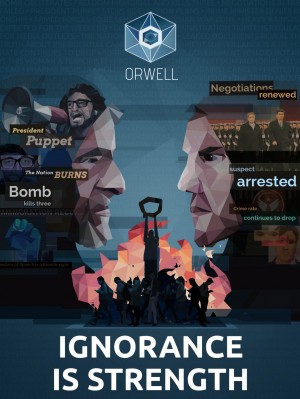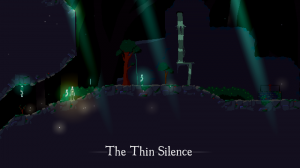Review for Code 7: Episode 1 – Threading page 2
Code 7, the self-proclaimed “Story-Driven Hacking Adventure” from indie German duo Goodwolf Studio, is essentially what one might expect, using a hacking mechanic as its main conduit of interaction. However, if the first full installment (of a planned four, not including the free Episode 0: Allocation prologue that was released separately as part of the game’s Kickstarter campaign) of this text-based adventure is any indication, this series is not going to be your ordinary hacking simulator. Featuring delicious sci-fi drama, generally excellent character voice-overs, atmospheric music, and addictive gameplay that bridges the gap between sim and adventure genres, Code 7 promises solid entertainment for players willing to stick out the title’s potentially lengthy production schedule.
The game takes place in the early 22nd century, putting the player in the role of Alex, who wakes up on a space station after a mysterious disaster. Through the comm system in Episode 0 (which is included as part of the full game and serves as an important lead-in to Episode 1), you meet a woman named Sam who claims to know who you are, although you apparently suffer from amnesia and cannot remember your past. Since you are separated, and seemingly only Sam is capable of moving throughout the station, you decide to work together in order to find each other, with you acting as her guide and she relaying what she sees in the rooms she encounters. Soon you find out that something horrible has befallen the station, and that a mysterious computer program known only as Code 7 has been activated and is on its way to Earth, with poorly understood but presumably terrible consequences. Sam is replaced in Episode 1 by another female companion named Zoya, whose role as a “real world” assistant to the player remains the same.
I was very impressed with the way Code 7’s story unfolded over the course of the first two episodes’ combined 7-8 hours of play, whether through communication with (or eavesdropping on) the people you encounter, reading emails to gain bits of information and backstory, or examining various documents you find on computers as you work your way through the station’s networks. Events involving your own character, such as interface distortions and creepy, near-subliminal messages that occasionally pop up on screen, also help flesh out the atmosphere and sensation that all is not as it seems. I was especially pleased with the way the game manages to have genuinely enthralling moments, such as when assisting someone’s escape from a hostile foe, through a primarily text-based interface.
There are different decisions you can make throughout, leading to slight variations in the way the plot plays out, such as choosing one location before another or pursuing optional objectives. It remains to be seen exactly how, or if, your choices and completed goals during Episodes 0 and 1 carry over to future installments, but the developers say they will at least affect the last one. There are a few key moments when decisions you make are considered significant. Some of these were obvious to me during play, and some I didn’t even know mattered until the end, when they are shown along with the percentage of other players who made each choice.
These opening two chapters present a rather typical yet intriguing sci-fi drama with a few twists and turns that some will likely see coming, but Code 7’s story is told with such conviction, and is enmeshed so deeply and naturally within the gameplay mechanics that it feels utterly fresh, despite the amnesiac-protagonist bit and a few other clichéd plot elements that I won’t spoil here. A more conventional adventure game structure might have accentuated these issues, but the hacking sim elements and a well-written and fully voiced script lend the plot a sense of urgency that defies the text-based presentation and kept me engaged in a way that I wasn’t really expecting. That’s not to say the story is a matter of style over substance, however. At the end of Episode 1, I am thoroughly excited to see how events will unfold, given that there are unanswered questions that left me begging to know answers.
What could have been a fairly conventional sci-fi tale is elevated by the game mechanics, which comprise a hybrid of interactive fiction and hacking sim. As such, I suspect that fans of either genre will find themselves in familiar territory with this game, although the learning curve for those unfamiliar with hacking sims will be somewhat steeper. While individual tasks that you encounter are fairly diverse, much of your time is spent gaining access to various computer systems in order to carry out a given task, such as gathering personal information, operating various devices, or unlocking a door for Sam and Zoya. (You will also encounter other, non-companion NPCs as well – some friendly, and some not so much.) Certain activities can only be completed with the help of your partner. For example, in one puzzle you must wait for her to scan a document into the computer that you can then use as a digital file.
Indeed, each companion needs your help to move through the locations (initially the doomed space station, with the action moving to another locale in Episode 1), as you have access to a top-down map of their surroundings. Labels mark the various halls and rooms that can be accessed, and icons indicate important items like computer systems in the environment. Once you have indicated to your partner where you would like her to go or what item you would like her to inspect, she will carry out your request. The overhead map is highly abstract, and characters on it are shown only as white dots. However, I never found this to be a particular hindrance to orienting myself, and in fact it was helpful to know at a glance what was going on at any given moment. Not everything is perfect, though. It is somewhat painful to backtrack, as the typical walking speed of your companion seems somewhat languid when you have to navigate from one end of an area to another a couple of times – a rare occurrence, thankfully.
It is also somewhat frustrating that moving from one place to another distant location can only be accomplished in stages rather than all at once, as the text console only allows currently visible tags to be used. The map only shows a certain amount of area around the companion character, and it cannot be moved to reveal more. So, to get somewhere that isn’t currently visible, one needs to enter a label that is visible, wait for your partner to get there, and then repeat this with another label closer to your goal, and so on, until you can see the desired final destination and finally type it in. Again, this is a somewhat minor quibble, but it is an unnecessary obstacle that could have been fixed by allowing you to type in an already-visited location’s label, or move the map in some way.
Much of your time in Code 7 is spent gaining entry to computers and networks, often after breaking through the defenses of whatever system you are trying to access. Navigating between systems works much the same way you direct your companion around, the significant difference being that you are able to hop instantly to and from systems connected to each other on the same network (signaled by a line connecting them). When you have successfully accessed a computer, a simple menu of its contents appears onscreen with options such as “Files,” “Documents,” or “Apps,” among others. These allow you to perform the action required, whether to simply read a set of emails or operate the controls of a physical device, such as a door or engine. System commands generally take an “APP[dot]ACTION” format, which will be instantly familiar to anyone who has used programming languages such as Java or Python. If I want to open an airlock door, I might type in “AIRLOCKDOOR.OPEN” to execute that command, or “NETWORK.LOGIN” to access a computer system on the current network.
Of course, just barging into any and all computer systems without some sort of resistance would be boring, so oftentimes you will have to solve a hacking minigame in order to gain access. There are two general types of hacks available, one called a bruteforce attack, the other a man-in-the-middle attack. The bruteforce attack is fairly simple and involves executing a keyboard combination, at which point the personal details gathered up to that point (mainly by reading emails and documents on other computers belonging to those acquainted with the target) will be used to try to guess the password.
A man-in-the-middle attack is more involved, and incidentally a bit more recognizable as a puzzle. Here a series of icons connected to each other appear onscreen, representing a simplified network map. Maneuvering between each numbered node and pressing the space bar allows you to find the source of the encryption key and track its movements throughout the system to the target computer. By placing a MIM packet on one of the nodes between the source of the key and the target computer, once the packet-laced key (depicted as a moving circle-shaped icon) reaches the target, you have access to that computer. Firewalls are often present, however, meaning that you may have to dodge them as they search for network threats, including your presence (upon finding you, the attempted hack fails and you have to start over) and intrusion packets (which don’t end the hack but do have to be replanted). Another technique for defeating firewalls involves using a tool to “freeze” the firewall temporarily while the packet is en route.
Those concerned that their technical skills might not be up to the challenge need not worry, as all commands are greatly simplified while still capturing the sense of being a hacker. And capture that sense it does, with gusto. Code 7 almost perfectly integrates the plot and gameplay together so that neither feels particularly complete without the other, and both evoke strong feelings of being a techno-wizard able to weave your way into, out of, and through the various computer systems. The fact that you and your companion must rely on each other to complete shared goals is a brilliant (and effective) way to instill an emotional connection with the characters, and is one of the most interesting aspects of the game.
At times action sequences are thrown your way, in which you have a limited amount of time to perform a set of tasks in order to save your own or your partner’s life. Such moments are impressive in their ability to make a modernized text adventure almost as exciting as any traditional action game, but they also reveal some of the more cumbersome aspects of the interface. Having to type multiple commands one after another in rapid succession is difficult at best, even with the ability to cycle through available commands (such as open or close) to save precious time. Unfortunately, those with significant dexterity issues may find one or two of these sequences impossible to complete, due to the extreme brevity of the allotted time to complete the actions involved. I doubt this would be the case for the vast majority of players, but it is worth noting for those with physical limitations.
Intriguingly, those with other physical issues such as blindness or epilepsy are in luck: certain keyboard combinations toggle two unique features in Code 7: a descriptive mode for the visually impaired, which describes the available commands onscreen, and the ability to turn off elements that flash colors in ways that might affect those vulnerable to them. Even though I don’t have epilepsy, I actually found this latter toggle useful, as the flashing elements distracted me during play. I don’t think I’ve ever seen a blindness mode in a game before, so the developers deserve credit for including this feature. (Update: According to Goodwolf, these timed sequences are not included in the blind-friendly mode, allowing those having trouble completing them to bypass them entirely by changing options mid-game, then saving and restarting with the mode disabled again.)
It is worth noting a few other details about the interface. For one, the only way to interact with the game is through the keyboard. There are no mouse-based tasks, nor is a cursor even visible during play. This reinforces the hacking sim conceit, though some features might have been more deftly handled through the mouse, such as allowing you to select map labels with a cursor rather than having to type them in. All actions are initiated through one or more keyboard shortcuts, as well as typing out or tabbing through available commands when accessing a given system or network. Autocomplete makes the console commands easier to type, as you can start typing a command and finish it by hitting tab. In general, the interface works well, and aside from the map navigation and timed actions revealing limitations with the keyboard-only interface, I found it quite easy to use.
Being a modern style of text adventure, a transcript of the audio appears to the left of the map in the upper right corner, allowing you to catch any dialogue you might have missed. In the lower left, a still image portraying your companion and a handful of others (there is an empty silhouette for a few characters as well) allows you to get a visual sense of the person addressing you. Multiple-choice dialogue options between you and your partner appear in the console section at the bottom of the screen, and often the choices are subtly different in tone. There is some branching involved in the dialogue, but not to the point of missing anything important the first time through, though the inclusion of different choices here (and in other key moments) means that there is some replay value.
Saving is automatic so it is impossible to go back and make different choices without starting over. You also do not have to play Episode 0 before starting Episode 1, but will be asked if you really want to do this, and if so, are given the option of answering a series of questions reflecting key points from Episode 0 in order to “reconstruct” the story. Again, how this might affect future episodes is unknown, but I would recommend starting at Episode 0, because the plot of Episode 1 makes no sense otherwise. And it’s included free!
The interface represents a large part of Code 7’s visual design, making it already more inviting than a screen of bare text, but some interesting techniques (such as graphical corruption, unsteady pixels, and color shifts) are used to make the game seem like it is being displayed on a futuristic monitor. Such techniques are employed during moments of high drama to add intensity, and it is these that can be disabled using the epilepsy-friendly mode, but I have to say I rather missed the added atmosphere when I disabled them. Unfortunately, you can’t pick and choose which effects to enable or disable. (Clarification: While you can't specify which elements to keep or remove, there is a numerical value setting that lets players adjust these effects to the desired level.)
Audio elements are fantastic on multiple fronts, adding immense value to the atmosphere. The fully-voiced script forges a link between your actions and the feedback in response that wouldn’t be as strong if the game were text-only (note, however, that the player’s own character, Alex, remains unvoiced). This is particularly the case during the quick-action sequences, but even when time isn’t of the essence, the emotions of the voice actors were able to influence my own feelings in ways I usually only associate with graphics-heavy games. With just an abstract map and few other visual elements to indicate what is happening, the game ends up being similar to a powerful radio drama, able to inspire even such feelings as fear and unease. The only criticism I can level at the voice-overs is that there are times when the script distinctly sounds like it is being read rather than acted, the actors faking their emotions in an unconvincing way, but even this never really overpowers the general success of the performances.
Music is also a large part of Code 7’s atmosphere, with a wide variety of tracks played to capture the mood of the moment, whether traversing a network prior to hacking a system, hearing a voice from a mysterious character, or helping your companion flee imminent danger. Most of the tunes are synth-based, evoking a certain cool, technological sophistication that I enjoyed very much, immersing me just that much more into this intriguing sci-fi world. Sound effects, meanwhile, are an integral but unobtrusive part of the sonic landscape; they aren’t especially noteworthy or unusual but blend into the action effectively.
Goodwolf Studio seems to have figured out how to merge the story- and character-centric nature of text adventures together with the cyberpunk skullduggery of hacking sims to create an exciting title that displays many of the strengths of both and few of the downsides of either. With some white-knuckle sequences thrown in to keep you on your toes, the possibility that some players might find them impossible to complete does cast a slight damper on the game’s appeal, but such issues won’t detract from the overall achievement for most. While the narrative does rely on some well-worn tropes, it never feels stale and the story and game mechanics complement each other to create a unified whole that works better than either would alone. Add to that an excellent soundtrack and a (usually) great voice-over cast, and the result is an unheralded jewel of the Kickstarter-generation indie scene. If the game’s next installments are as great as these first two, we have a lot to be excited about in the future.



_capsule_fog__medium.png)


























